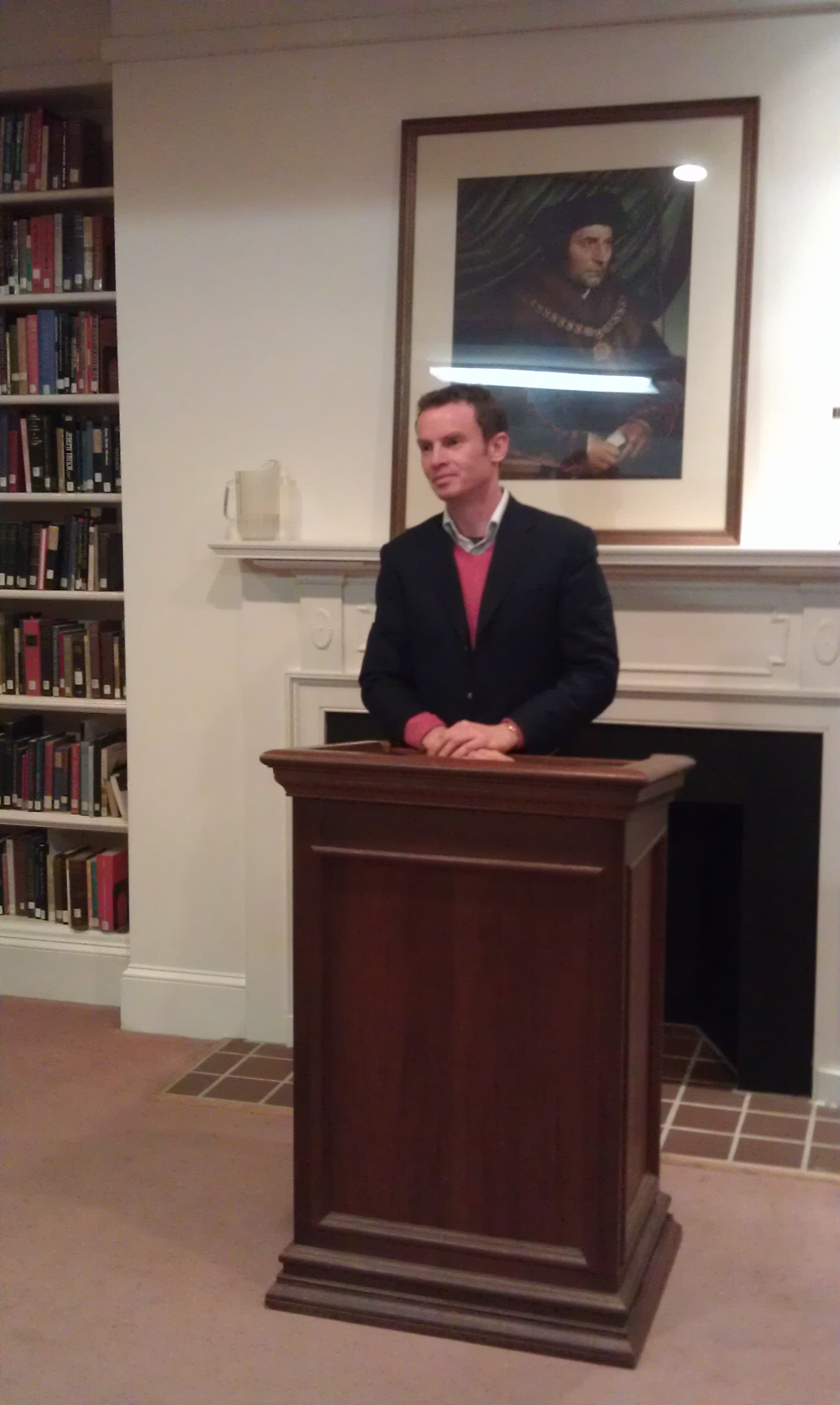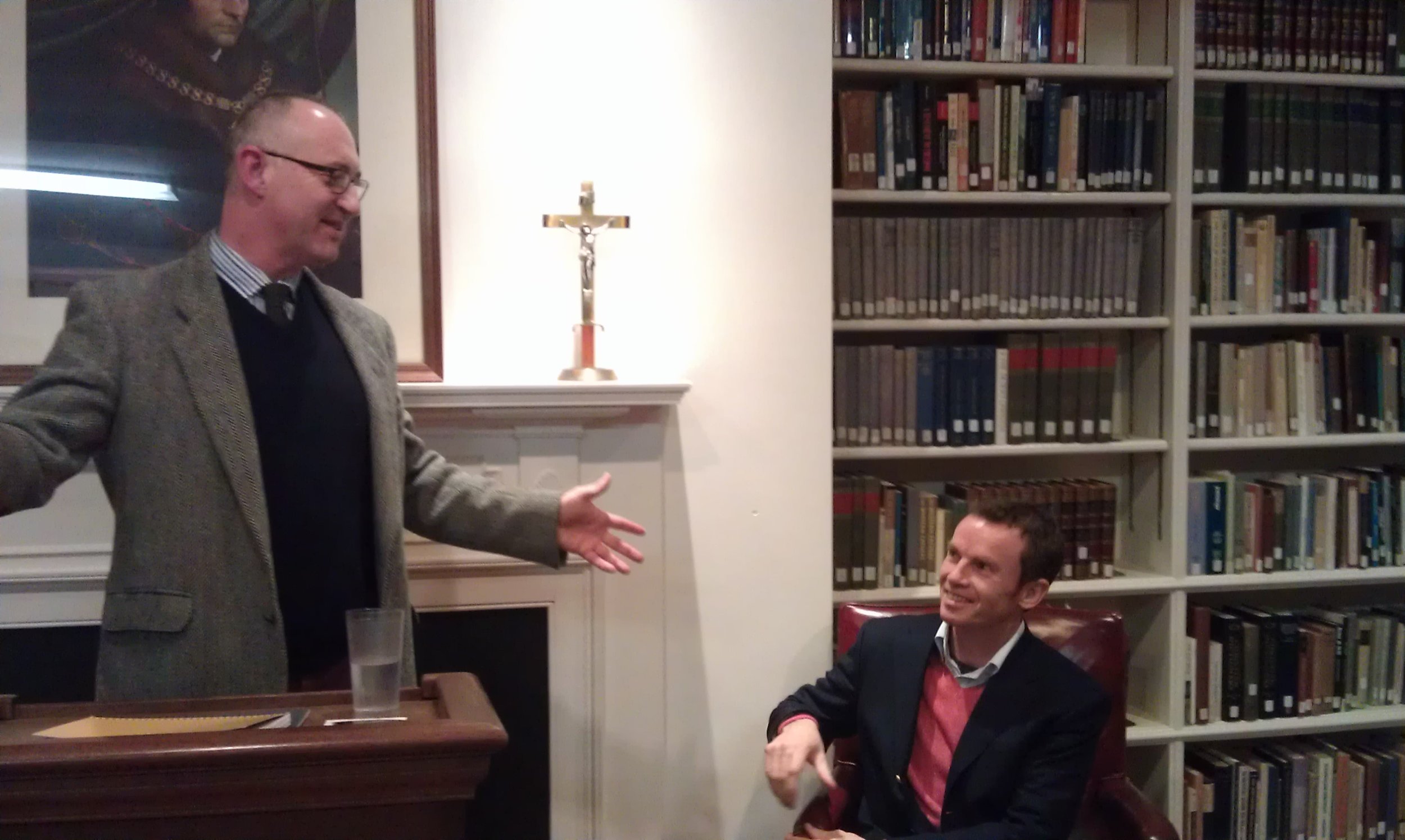How an Artist Can Conquer the World When Armed With the Arrows of Beauty
 James Gillick Inspires Students at Thomas More College. Aspiring artists are 10 a penny. Successful artists are rare; successful Catholic artists who succeed in secular markets and can articulate clearly the basis of their success are rarer still. So when you get a chance to talk to one who does well enough that he can afford to pay four apprentices a year to work in his studio he is worth listening to; especially when he is an eloquent speaker and understands the basis of his success.
James Gillick Inspires Students at Thomas More College. Aspiring artists are 10 a penny. Successful artists are rare; successful Catholic artists who succeed in secular markets and can articulate clearly the basis of their success are rarer still. So when you get a chance to talk to one who does well enough that he can afford to pay four apprentices a year to work in his studio he is worth listening to; especially when he is an eloquent speaker and understands the basis of his success.
On 22st January, Englishman James Gillick, one of the UK's most successful artists and a Catholic came to Thomas More College of Liberal Arts and spoke about his faith and his approach to business and working in a secular world. Speaking to a packed Helm Room, his talk was impassioned and inspiring. When he finished students gathered around asking for advice to help them as they step out in the next phase of their lives.
He began by passing on good wishes from his most recent apprentice - former TMC student Jacqueline del Curto to her friends in the audience. Then he began his talk. He is the son of Victoria Gillick, whom Britons of my generation (I am 51) will remember as the Catholic who in the 1980s took the British government all the way to the highest court, the Law Lords, to try to overturn a law which allowed doctors to prescribe he contraceptive pill to girls under 16 without informing their parents (ultimately the government won). He spoke of this and what a profound effect it had on him as a boy watching the treatment of his mother and her resolve in the face of it - hostility from the government, from feminists, from from the newspapers and television and the resulting abandonment of friends; and how this gave him a sense of a mission as a Catholic that could be translated even into the work of an artist. 
In regard to his own work he spoke first of the apparent hopelessness of the situation facing Catholics today. We have an aggressively anti-Catholic, materialist society in the which leading figures are the very wealthy devoted to getting more. These are the people that he must win over in order to sell his paintings. He told us of the process whereby he carefully worked out what sorts of paintings would appeal to these people. He chose subjects that suggested stability and solidity - qualities that those who work in the unpredictable world of finance wish to communicate to others, and convince themselves they possess. Consistent with this, in my opinion, his still lives particularly, through subjects such as game birds, and his portraits evoke a sense of traditional landed gentry of the Britain of Downton Abbey and before. He described also he carefully calculated how he could paint so that his work was consistent also with the Faith. This is an assumed faith rather than something explicit, so anyone who looks at his work will see that what he has done is look first to the liturgical forms. He has picked the baroque and based his style, whether religious or mundane art, on this. I think that this is exactly the right approach: it arises from a vision of a popular contemporary culture that will subtly develop the liturgical instincts of those who do not go to church, preparing their hearts for the mysteries that are manifested in Sacred Liturgy, and stimulating a desire for it - even if initially they are not aware that this is what they seek.
For James Gillick beauty as the main weapon we have in the secular world. Armed with it we cannot fail, he thinks. As he spoke it seemed to me that what he was describing is a process giving love until they submit. I was reminded of the quotation of our Pope Emeritus who wrote: 'True knowledge is being struck by the arrow of beauty that wounds man: being touched by reality, “by the personal presence of Christ himself,” as Nicholas Cabasilas puts it. Being overcome by the beauty of Christ is a more real, more profound knowledge than mere rational deduction. Of course we must not underestimate the importance of theological reflection, of exact and careful theological thought; it is still absolutely necessary. But to despise, on that account, the impact produced by the heart’s encounter with beauty, or to reject it as a true form of knowledge, would impoverish us and dry up both faith and theology. We must rediscover this form of knowledge—it is an urgent demand of the present hour. …' It struck me that the 'arrows of beauty' are a set of a true Cupid's darts whose effect is not disordered desire but rather a properly ordered love of God.
Gillick explained that our only chance of success is for us to be united in our worship and prayer to the source of that beauty and hope, Christ.
When asked why there seemed to be such a market for ugliness, he commented that while fashion can stimulate demand in the short term for the trivial and titilating, people do respond to beauty when presented with it and that response is generally stronger and more long term. The reason that so little beauty is bought, he suggested, is that so little of it is available for sale - very few artists today are capable of producing current forms that participate in the the divine beauty and have anything of the sort of lasting value that artists of the past used to be able to create.
He spoke of his inspiration in looking at British history and the parallels he sees with today's situation. The Normans, who invaded in the 11th century, set themselves up as a brutal, self-serving class who dominated and subjugated the population of Britain. However, they were changed by the rise of the gothic culture of beauty which attracted them and transformed them and British society into a culture of beauty that was so resplendent that Britain was referred to as Our Lady's Dowry. If we engage beautifully with the secular culture, whether as artist, or musician or writer, or just Christian who lives life well and gracefully, with charity then we have nothing to fear and we can change the world. However, we do need to have a clear sense of purpose to guide us and a foundation in the Church. If we have that then today's Normans can be transformed just as those of yesteryear were.
I have known Jim for about 15 years and what always strikes me when he talks about art is he contrast between the description of the mission that he believes he is on, and the means by which he strives to achieve it as an artist and a father. When he talks of his work is very practical and straightforward - certainly not the precious, angst ridden bohemian of the popular artist image. He talks of his belief that artists need talent and dedication so that they can work hard and produce many paintings that are good enough to sell for a high price. Only then will he be able to support his family. When he discusses his role in changing the culture and his family, he is seemingly humbled and awestruck that he can even contemplate aiming to fulfil such a high calling. But as he points out, we are called to achieve amazing things by humble work - it is Christ who can give it the seemingly miraculous result.
From top: speaking from the podium, my introduction of him to the students; and then below talking to students afterwards. Below that two of his paintings - his portrait of Margaret Thatcher, painted to commemorate her being Chancellor of Buckingham University (Britain's only non-government funded university); and point-to-point horses.



